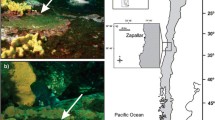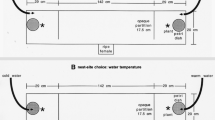Abstract
Parental care can be costly to a parent in terms of both time and energy invested in the young. In species with cuckoldry or brood parasitism not all of the young under a parent's care are necessarily offspring. In such cases, distinguishing between kin and non-kin, and investing only in the former (nepotism), can be advantageous. Bluegill sunfish (Lepomis macrochirus) are characterized by paternal care and cuckoldry, and care-providing males appear to show nepotistic behaviours. Here, we investigated nestling recognition in bluegill, determining whether parental males can differentiate between young from their own nest (familiar and related) and young from non-neighbouring nests (unfamiliar and unrelated) using (1) visual and chemical cues, and (2) chemical cues only. In the first experiment, wild-caught parental males were presented with samples of eggs or fry (newly hatched eggs) collected from their own nest or a foreign nest and placed on opposite sides of an aquarium. The time these parental males spent associating with each sample, and their "pecking" behaviours (indicating cannibalism), were recorded. Parental males showed no preference between eggs from their own nest and eggs from a non-neighbouring nest, but they preferred to associate with fry from their own nest over foreign fry. There also was a positive relationship between male body size and the time spent associated with fry from their own nest. Parental males pecked at foreign fry more than 5 times as often as fry from their own nest, though this difference was not statistically significant. In the second experiment, fry that were collected from the nest of a wild-caught parental male or a non-neighbouring nest were placed in different containers and the water from each was dripped into opposite ends of an aquarium. The time the male spent on each side was recorded. In this case, parental males spent more time near the source of water conditioned by unrelated fry, but there was a positive relationship between male condition (fat reserves) and the time he spent near the source of water conditioned by fry from his own nest. Results confirm that chemicals cue nestling recognition by parental male bluegill.


Similar content being viewed by others
References
Alexander RD (1990) Epigenetic rules and Darwinian algorithms: the adaptive study of learning and development. Ethol Sociobiol 11:241–303
Arnold KE (2000) Kin recognition in rainbowfish (Melanotaenia eachamensis): sex, sibs and shoaling. Behav Ecol Sociobiol 48:385–391
Brown GE, Brown JA (1996) Kin discrimination in salmonids. Rev Fish Biol Fish 6:201–219
Brown GE, Brown JA, Crosbie AM (1993) Phenotype matching in juvenile rainbow trout. Anim Behav 46:1223–1225
Brown JA, Colgan PW (1986) Individual and species recognition in centrarchid fishes: evidence and hypotheses. Behav Ecol Sociobiol 19:373–379
Chivers DP, Smith RJF (1998) Chemical alarm signalling in aquatic predator–prey systems: a review and prospectus. Ecoscience 5:338–352
Coleman RM, Fischer RU (1991) Brood size, male fanning effort and the energetics of a non-shareable parental investment in bluegill sunfish, Lepomis macrochirus (Teleostei: Centrarchidae). Ethology 87:177–188
Crozier RH, Dix MW (1979) Analysis of two genetic models for the innate components of colony odor in social Hymenoptera. Behav Ecol Sociobiol 4:217–224
Fletcher DJC, Michener CD (eds) (1987) Kin recognition in animals. Wiley, New York
Grosberg RK, Quinn JF (1986) The genetic-control and consequences of kin recognition by the larvae of a colonial marine invertebrate. Nature 322:456–459
Gross MR (1982) Sneakers, satellites and parentals: polymorphic mating strategies in North American sunfishes. Z Tierpsychol 60:1–26
Keller L, Ross KG (1998) Selfish genes: a green beard in the red fire ant. Nature 394:573–575
Kempenaers B, Sheldon BC (1996) Why do male birds not discriminate between their own and extra-pair offspring? Anim Behav 51:1165–1173
Lacy RC, Sherman PW (1983) Kin recognition by phenotype matching. Am Nat 121:489–512
Lee DS, Gilbert CR, Hocutt CH, Jenkins RE, McAllister DE, Stauffer JR Jr (1980) Atlas of North American freshwater fishes. North Carolina State Museum of Natural History, Raleigh, N.C.
Loiselle PV (1983) Filial cannibalism and egg recognition by males of the primitively custodial teleost Cyprinodon macularius californiensis Girard (Atherinomorpha: Cyprinodontidae). Ethol Sociobiol 4:1–9
Lotem A (1995) Learning to recognize nestlings is maladaptive for cuckoo, Cuculus carnoris, hosts. Nature 362:743–745
Lotem A, Nakamura H, Zahavi A (1992) Rejection of cuckoo eggs in relation to host age—a possible evolutionary equilibrium. Behav Ecol 3:128–132
Lutnesky MMF (1989) Attraction to larval pheromones in female convict cichlids (Cichlasoma nigrofasciatum). J Comp Psychol 103:297–305
Mateo JM (2002) Kin-recognition abilities and nepotism as a function of sociality. Proc R Soc Lond B 269:721–727
McKaye KR, Barlow GW (1976) Chemical recognition of young by the Midas cichlid, Cichlasoma citrinellum. Copeia 1976:276–282
Moore A, Ives MJ, Kell LT (1994) The role of urine in sibling recognition in Atlantic salmon Salmo salar (L.) parr. Proc R Soc Lond B 255:173–180
Myrberg AA Jr (1975) The role of chemical and visual stimuli in the preferential discrimination of young by cichlid fish Cichlasoma nigrofasciatum (Günther). Z Tierpsychol 37:274–297
Neff BD (2000) Genetic markers and breeding success: theoretical and empirical investigations in fish. PhD thesis, University of Toronto, Toronto, Canada
Neff BD (2001) Genetic paternity analysis and breeding success in bluegill sunfish (Lepomis macrochirus). J Hered 92:111–119
Neff BD, Gross MR (2001) Dynamic adjustment of parental care in response to perceived paternity. Proc R Soc Lond B 268:1559–1565
Neff BD, Sherman PW (2002) Decision making and recognition mechanisms. Proc R Soc Lond B 269:1435–1441
Nelson CTJ, Elwood RW (1997) Parental state and offspring recognition in the biparental cichlid fish Pelvicachromis pulcher. Anim Behav 54:803–809
Olsén KH, Grahn M, Lohm J (2002) Influence of mhc on sibling discrimination in Arctic char, Salvelinus alpinus (L.). J Chem Ecol 28:783–795
Philipp DP, Gross MR (1994) Genetic evidence of cuckoldry in bluegill Lepomis macrochirus. Mol Ecol 3:563–569
Quinn TP, Busack CA (1985) Chemosensory recognition of siblings in juvenile coho salmon (Oncorhynchus kisutch). Anim Behav 33:51–56
Reeve HK (1989) The evolution of conspecific acceptance thresholds. Am Nat 133:407–435
Sherman PW, Reeve HK, Pfennig DW (1997) Recognition systems. In: Krebs JR, Davies NB (eds) Behavioural ecology: an evolutionary approach, 4th edn. Oxford University Press, Oxford, pp 69–96
Sutton SG, Bult TP, Haedrich RL (2000) Relationships among fat weight, body weight, water weight, and condition factors in wild Atlantic salmon parr. Trans Am Fish Soc 129:527–538
Tibbetts EA (2002) Visual signals of individual identity in the wasp Polistes fuscatus. Proc R Soc Lond B 269:1423–1428
Trivers RL (1972) Parental investment and sexual selection. In: Campbell B (ed) Sexual selection and the descent of man. Aldine Press, Chicago, pp 136–179
Waldman B, Frumhoff PC, Sherman PW (1988) Problems of kin recognition. Trends Ecol Evol 3:8–13
Westneat DF, Sherman PW (1993) Parentage and the evolution of parental behaviour. Behav Ecol 4:66–77
Westneat DF, Clark AB, Rambo KC (1995) Within-brood patterns of paternity and paternal behaviour in red-winged blackbirds. Behav Ecol Sociobiol 37:349–356
Whittingham LA, Lifjeld JT (1995) High paternal investment in unrelated young—extra-pair paternity and male parental care in house martins. Behav Ecol Sociobiol 37:103–108
Zar JH (1999) Biostatistical analysis, 4th edn. Prentice-Hall, Upper Saddle River, N.J.
Acknowledgements
We thank Rob J. Gegear, James Hare, Terence M. Laverty, Trevor E. Pitcher, and four anonymous reviewers for comments on the manuscript. H. Kern Reeve kindly provided the video camera, Joanna Lister provided field assistance, and Frank Phelan and Floyd Connors provided logistical support at the Queens University Biological Station. This work was supported by NSERC of Canada (BDN), and by the U.S. National Science Foundation and the Agricultural Experiment Station at Cornell (PWS). The experiments presented in this study comply with all laws for animal use in Canada (Canadian Council on Animal Care); fish were collected under permit 1000713 issued by the Ontario Ministry of Natural Resources.
Author information
Authors and Affiliations
Corresponding author
Rights and permissions
About this article
Cite this article
Neff, B.D., Sherman, P.W. Nestling recognition via direct cues by parental male bluegill sunfish (Lepomis macrochirus). Anim Cogn 6, 87–92 (2003). https://doi.org/10.1007/s10071-003-0166-y
Received:
Revised:
Accepted:
Published:
Issue Date:
DOI: https://doi.org/10.1007/s10071-003-0166-y




